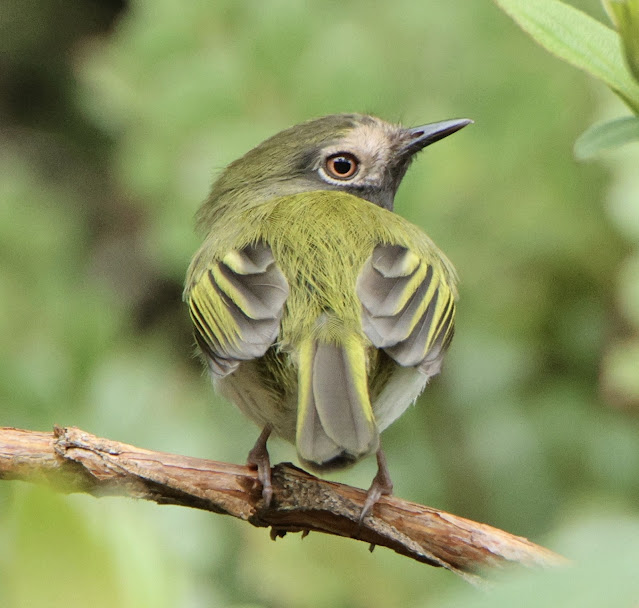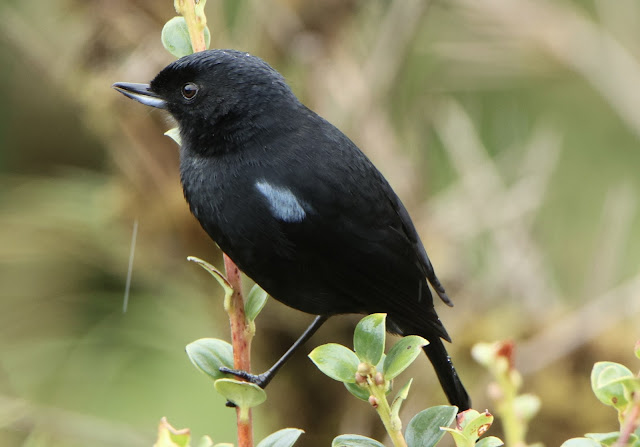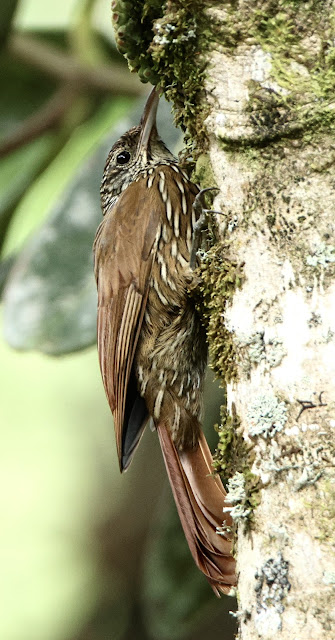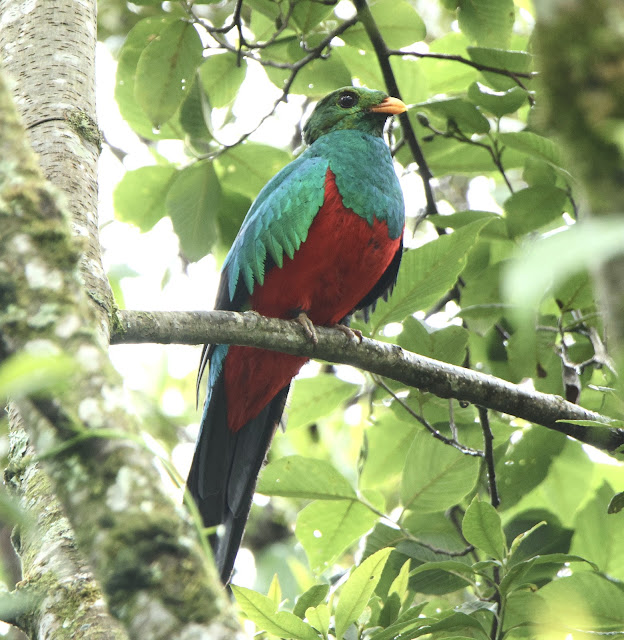SOUTH ECUADOR BIRDING TRIP
PART ONE - THE WEST SIDE
The first half of this tour was mostly on the west side of the Andes, and we’d visit some of the more well known areas described below.
On February 12, I left at 5:30 to pick up 2 friends from Oregon at the local airport in Catamayo, Aaron Beerman and Tim Johnson, for a birding excursion I had planned for them in South Ecuador. It had rained hard that night so there were plenty of new rocks in the road as well as mud and large puddles, so I was glad for the light of dawn to see the road better. When the rainy season comes, the steep hillsides let loose their quarry, which often ends up in the road. And there are not many straight roads in the Andes, and roads built on steep mountain sides are common.
They were supposed to arrive at 07:00, but Aaron informed me via texts of a delay…….. and then another one….. and another one. Apparently it was a mechanical problem and another plane was needed, so take off took place at 11:20 or so, and they finally got here shortly after noon. It was great to be with some friends from my (former) home area, and we immediately hit the airport area for birds.
By now it was sunny and hot, and birding activity had decreased to its usual midday low, but we would make the best of it. One target bird I planned to show them was the Peruvian Meadowlark, and we saw a few in short order. They are quite similar to the meadowlarks in the states, except the yellow features are replaced with red.
 |
| PERUVIAN MEADOWLARK |
Grassquits and Seedeaters are a plenty in the area and easy to find. The Pacific Parrotlets, which have been quite prevalent here, had paired off for nesting and were no where to be found, a little bit of a let down since I really wanted them to see one of the smallest parrots in the world.
On the opposite side of the runway is a road which parallels it, and birders go here to find the species mentioned. When we reached the turn around area, we used playback to call in a Peruvian Pygmy Owl. They are very common and Tim was quick to take his picture. But when he looked in the camera screen to see the results, there were none! So he checked his flash card to find it was not fully in place, so up to this point he had missed obtaining all the pictures he thought he was taking, so had to start over.
We next drove to the south to an area where I had recently seen a pair of Comb Ducks along a river. But first we pulled off just before a bridge to look at the Gray-breasted Martins which were nesting there. Just after stepping out of the car, Aaron spied another Pygmy Owl perched close by, so Tim got his chance at the photo op and took advantage of it. We then drove on the road along side of the river looking for the Comb Ducks, but did not have success. We did see a few Southern Rough-winged Swallows.
 |
| PERUVIAN PYGMY OWL |
We returned north a few miles to where the road heads SE toward Vilcabamba (my home) to look for a Tumbes Sparrow, without success. Aaron and I did see one Comb Duck flying down stream though. At this road junction it can be fairly birdy at times, and we saw Golden Grosbeaks, White-lored Gnatcatchers, Plumbeous-backed Thrushes, Shiny and Giant Cowbirds, an Amazelia Hummer, Saffron Finches and a few others.
 |
| GOLDEN GROSBEAK |
We made the hour plus drive to my house. The guys were happy to rest after the night flight from the states and a 6 hour delay for the domestic flight, finally finding solace in knowing things should now go smoothly and they’d each have there own bed rooms. My wife, who loves to please people with her cooking skills, made a nice evening meal which was eaten while being serenaded by the local Common Pauraque. And they would enjoy a good nights rest
While having coffee on the back patio the following morning a local Peregrine Falcon circled over. About 7:00 we took off to town. I had checked the beginning of the trail up Cerro Mandango a couple times the preceding week, a popular hike up the small mountain that overlooks Vilcabamba, which was showing signs of lots of birds. The area did not let us down. We added Black & White Tanagers, Purple-throated Woodstars, Ecuadorian Piculet, Southern Beardless Tyrannulet, Mouse-gray Flycatcher, Hooded Siskins, Three-banded Warblers, and a hard to get Bay-crowned Brushfinch. The Elegant Cresentchest and Collared Antshrike vocalized, but did not come out for a visual.
 |
| FEMALE PURPLE-THROATED WOODSTAR |
 |
| BLACK & WHITE TANAGER |
 |
| WHITE-LORED GNATCATCHER |
Next we went across town and walked a road which goes up a shaded ravine for about a mile. The week prior I had found a pair of Whooping Motmots attending a nest, and we saw one when we approached that area. Due to the rains that night we would park on the uphill side of the creek crossing, walk to the next one, then I or Aaron would walk back to get the car so we could continue on. The birding continued to be decent and we added Boat-billed Flycatchers, Rufous-browed Peppershrikes, Brown-capped Vireos, Chiguanco and Ecuadorian Thrushes, a Yellow-tailed Oriole, Hepatic and Summer Tanagers, and a few more Motmots.
 |
| WHOOPING MOTMOT |
From there we went to town for breakfast, and then walked part of the popular trail along the river. In prior weeks I was made aware of nesting Great Kiskadees, Piratic Flycatchers and One-colored Becards. But we were only able to find the male Becard, which was nice since they can be difficult to find otherwise. Two others to grace our list here was a Gray & Gold Warbler and Golden-olive Woodpecker.
From there we went to the next small town a mile north and drove a couple miles along a river to the end of the road, to the trout restaurant. The target birds here were White Capped Dipper and Torrent Ducks. After obtaining permission from the restaurant owner, we walked on the trail further upstream. We could hear a bird vocalizing which we thought was the Dipper, but never got a visual on it. We meandered back to the restaurant area, about to admit defeat. But then we spied a male Torrent Duck making his way upstream, maybe 50 feet away. We watched him swim right by us, making his way to a young Torrent Duck not far away. As it was getting late in the day, we returned to my place for the night.
 |
| ADULT MALE TORRENT DUCK |
 |
| IMMATURE MALE TORRENT DUCK |
We were up early the next day for our jaunt to Cerro Toledo, a half hour drive to the south of Vilcabamba. At 6:30 we picked up John Mills in town. John is a local birder who has lived here for a couple years and knows the area quite well. He also knows the birds by their calls. At the meeting place in town was a Yellow-belied Elaenia and a Palm Tanager, both rare for our immediate area, so we were off to a good start.
A half hour later we were ascending the Cerro Toledo road. We would be stopping often for birds. Our first stop, only a few hundred meters up the road yielded 13 species, including Amazelia Hummer, Crimson-mantled Woodpecker, Azara’s Spinetail, and Slate-throated Redstart.
The next few stops - Purple-throated Sunangel, Speckled Hummingbird, Green-tailed Trainbearer, Rainbow Starfrontlet, Speckle-faced Parrot, Line-cheeked Spinetail, Sierran Elaenia, Mountain Wren and Gray-browed Brushfinch. This last entry, the Gray-browed Brushfinch was # 100 for the trip. At one point I walked back downhill to get the car, and when I returned John said, “I think I heard the Tody”. The Black-throated Tody-Tyrant has been my jinx bird on Cerro Toledo, and John finds it up there more often than not. No sooner had he said that and one popped up over my left shoulder, then flew across the road. A lifer:
 |
| BLACK-THROATED TODY TYRANT |
We slowly worked our way to the paramo where the wind and clouds often impede birding, and today was an example of this difficulty. About 2/3 to the top we ran into some other birders. Nelson Apollo, one of Ecuador’s best birding guides was leading two Brits around Southern Ecuador, and he relayed that the weather at the top was deteriorating, so we decided to head straight there. He happened to be good friends with John, so it was a little reunion of sorts. Little did we know but our paths would cross often for the rest of our trip.
Visibility at the top was maybe 100 meters, and it was cold. But my friends would never be here again, so we stuck it out. John knew just where to look for certain species, the Neblina Metaltail being the big prize for birders who come here. This is basically the only place in the world to find one fairly easily. With a little persistence one came to playback, and so pictures were taken:
 |
| NEBLINA METALTAIL |
A little later we had the same good fortune with calling in a Rainbow-bearded Thornbill.:
 |
| RAINBOW-BEARDED THORNBILL |
 |
| GLOSSY FLOWER-PIERCER |
Others we found up top were Mouse-colored Thistletail, Loja Tapaculo, Chestnut-winged Cinclodes, Chusquea Tapaculo, Glossy Flowerpiercer, White-collared Swift, and Many-striped Canastero. In all we tallied 65 species for our day on Toledo, which is a very good count considering it is now nesting season and mixed flocks are uncommon. Thanks to John for his expertise while being with us.
The next day we’d be up early. Our plan was to go to Tapichalaca, the reserve an hour south of Vilcabamba. We’d need to be there by 07:00 to meet our guide Diego. At 5:30 we picked up Charlie Renideo, a friend from town and long time photographer, who especially likes to photograph birds. He had asked me about joining us at this conjecture in the trip, to which I was most agreeable. I was worried about having to drive in thick fog as sometimes happens on this drive, but we had no problems with such.
Birding at Tapichalaca is a prime example of the highs and lows of birding in Ecuador. Because of the thick foliage, birds are sometimes hidden (frustrating), but when they appear (exhilarating), it is well worth it. We met Diego our guide, who has fantastic hearing and knows all the bird calls. Some of the highs were seeing Red-hooded Tanagers, Golden-plumed Parakeets, an Equatorial Antpitta, Capped Conebills, a Black-capped Hemispingus, Bearded Guans, Rufous-breasted and Orange-banded Flycatchers, a Grass-green Tanager, and 9 species of hummers. Some of the let-downs: The Jococtoco Antpitta did not come in to eat nor did one vocalize. And there were about half of the 61 species tallied which we did not get great looks at, or only hear. Such is jungle birding. Nelson and the two Brits had stayed there that night, so we compared notes, and also found out we’d meet again at Copalinga in a few days.
 |
| RED-HOODED TANAGER |
 |
| BLUE & BLACK TANAGER |
 |
| SPECTACLED REDSTART |
 |
| RUFOUS-BREASTED FLYCATCHER |
We were done there around 11:00 and then drove down to Valladolid, about 10 miles downhill, where it began raining, so we donned rain gear and kept at it. We walked a trail by the river, and then drove a road higher up to the east of town. In about an hour the rain stopped. We then returned to town and walked along a road that paralleled the highway. Some of the better birds we saw were Russet-backed Oropendulas, Rufous-capped Thornbirds (with their huge nests), Sparkling Violetears, Pale-eyed Thrush, Green Jays, Blue-necked and Golden-eared Tanagers, Montane Foliage Gleaner, Montane Woodcreeper, Olivaceous Siskin, Bronzy Inca, Highland Elaenia, Golden-faced Tyrannulet, Silvery and Saffron-crowned Tanagers, and the common Roadside Hawk.
 |
| ROADSIDE HAWK |
 |
| MONTANE WOODCREEPER |
 |
| GRAY BREASTEDFLYCATCHER |
 |
| RUFOUS-FRONTED THORNBIRD |
 |
| NEST OF THE THORNBIRD |
 |
| GREEN JAY |
By now it was getting late in the day and we drove on to Palanda, got settled in to our hotel, and after a while went out to eat. I am unsure what the bird tally was by then, but we were racking them up, and tomorrow would be more of the same. We were now on the east side of the continental divide, in an area which was a nice mix of eastern and western birds, as well as some whose northern Peru range ends here, so the birding has great potential, and the eBird accumulated checklist for Valladolid had over 400, more than the Tapichalaca Reserve.
We were up at 06:00 and off to a road just south of town, which goes up a mountain. I had been here twice in October, and the main target to look for is the Chestnut-crested Cotinga. (I had seen them twice) But there were plenty of others to find as well. We spent most of the morning here, but higher up the road was blocked by a landslide, so we were limited as to how high we’d go. By mid morning the sun was out clear and bright, so the birding activity was waning. But we did OK adding the following: Little Tinamou (heard only) Speckled Chachalaca, Andean Emerald, Yellow-tufted Woodpecker, White-eyed Parakeet, Blackish Antbird, Western Fire-eye, Piratic Flycatcher, White-necked Thrush, Chestnut-capped Brushfinch, Summer Tanager, and finally a Paradise Tanager. One spiffy bird we saw was the Blue-naped Chlorophonia. The Cotinga was not found, a little bit of a let down.
 |
| YELLOW-BROWED SPARROW |
 |
| RUDDY PIGEON |
From there we headed north of town, stopped for a coffee break, then went to some Incan ruins. By now it was hot, but we still cranked out a few more birds such as: Black-faced Dacnis, Green-backed Becard, Olivaceous Greenlet, Maranon Thrush, Orange-bellied Euphonia, Spotted Tanager, Chivi Vireo and a Bananaquit, which was # 200 for the trip. And the Paradise Tanagers were quite obliging, so we got a few decent pictures.
 |
| PARADISE TANAGER |
 |
| PARADISE TANAGER |
Afterwards we dropped Diego off back in Palanda and meandered back to my house. En route in the highlands Aaron saw a few birds out the window, so we stopped and got great looks at a Rufous-capped Thornbill and Golden-headed Quetzal:
 |
| GOLDEN-HEADED QUETZAL |
 |
| RUFOUS-CAPPED THORNBILL |
 |
| ONE OF THE LARGER LANDSLIDES AS HAPPENS IN THE RAINY SEASON |
My wife had cooked us another nice meal which added to the general contentment. The trip was about half way through, and things were going fine.
Here is a map of the entire area where we were. The orange highlighted roads are the basic route, and the underlined towns are land marks mentioned in the script:

No comments:
Post a Comment